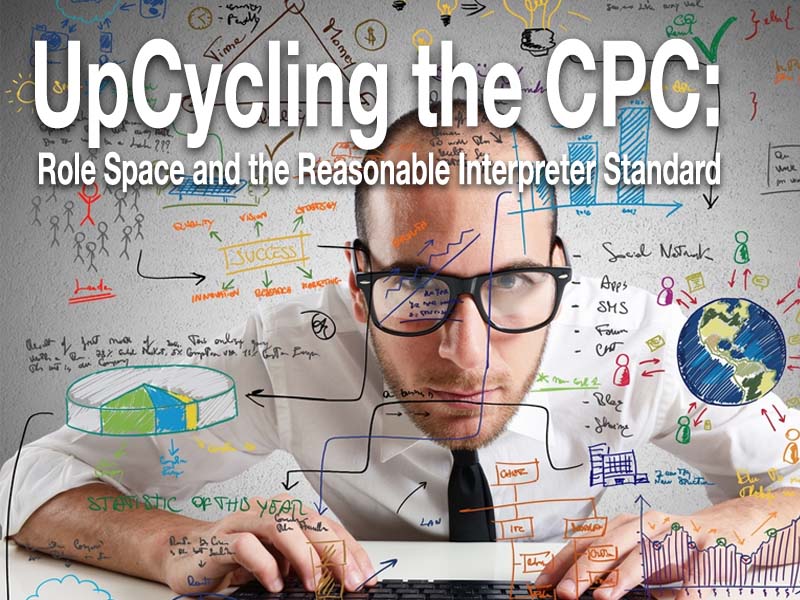
Receiving feedback is as much an art as giving it. By crafting opportunities to receive feedback, sign language interpreters can begin to erase the negative connotations that often accompany the “F” word.
Several hours after a recent interpreting assignment, I received an email from my team interpreter that simply said, “Can we chat about today?” I had an immediate hunch that I was soon to receive feedback about my performance and, despite the year of study I’ve committed to better understanding accountability and the art of receiving feedback, I froze.
Thanks to Sheila Heen and Doug Stone,1 I had the tools to prepare me for this feedback conversation and so I found a spot to sit that was free of distraction and called my colleague. For the next half hour, we successfully navigated what could have been a stressful conversation. As it turns out, I behaved that day in ways that were off-putting, and though I’d like to believe these behaviors were unrecognizable to an outsider, what mattered was that all of them impacted how my colleague experienced the day.
Sign Language Interpreters and Accountability
As sign language interpreters and engaged citizens of the world, we have countless daily opportunities to both give and receive feedback, which means we also have countless opportunities to have conversations that are a success, that go awry, and that fall somewhere in between. Let’s pause for a moment. Can you recall the last time you:
- worked with an interpreter whose product was not up to snuff;
- associated with a colleague who didn’t walk the talk in her or his commitment to the Deaf community;
- were booked to team an assignment with a colleague who is notoriously late; or
- worked with someone whose behavioral decisions were a turn-off for Deaf and hearing people, and drew undue attention?
Turning the tables, what about the last time a colleague thought you were any of the above? I believe if we are all better prepared to try on ideas that may at first seem off-point, that we’ll develop a more nuanced capacity for empathy and learning, which will in turn make us more proficient practitioners.
Feedback: Challenge or Opportunity?
Feedback is certainly not always a challenge to receive. It “…includes any information you get about yourself. In the broadest sense, it’s how we learn about ourselves from our experiences and from other people — how we learn from life. … So feedback is not just what gets ranked; it’s what gets thanked, commented on, and invited back or dropped.”2 Because we’ll come into contact with solicited and unsolicited feedback every day, from colleagues and not, practicing the art of receiving it is a worthwhile investment for all.
“The real leverage is creating pull.”3
Yes, it’s true that if everyone was more adept at sharing feedback, then we may be able to devote less attention to the art of receiving it. One might make the case, however, that because feedback comes in many forms and from many different people, the only control we will have on how “appreciation (thanks), coaching (here’s a better way to do it), and evaluation (here’s where you stand)”4 are delivered is in how they are received (in other words, we have no control on how feedback is delivered). The giver can be as eloquent or offensive as they choose; it is the receiver who decides whether or not to listen to what is said, how to interpret it, and what to do with it.
Shifting the Feedback Dynamic
With this awareness, I’m hopeful that the sign language interpreting field can begin to shift the feedback dynamic. Instead of investing most of our energy in refining the art of giving feedback, let’s get on board with the receiver soliciting feedback and guiding its provision. In fact, seeking feedback, for better or worse, supports one’s job satisfaction and allows more creativity to solve problems more easily.5 With a job that has been deemed the most cognitively complex task of which humans are capable,6 it’s likely useful to free up some mental energy for problem-solving.
“Creating pull is about mastering the skills required to drive our own learning; it’s about how to recognize and manage our resistance, how to engage in feedback conversations with confidence and curiosity, and even when the feedback seems wrong, how to find insight that might help us grow. It’s also about how to stand up for who we are and how we see the world, and ask for what we need. It’s about how to learn from feedback—yes, even when it is off base, unfair, poorly delivered, and frankly, you’re not in the mood.”7
Let’s move forward together — toward a place where we are genuinely interested in being held accountable and one where we seek feedback of all sorts, so as to enrich the practice of interpreting across the profession.
Managing Relationship, Truth, and Identity Triggers
Despite one’s uneasiness at receiving honest observations about their work, actions, and the impact these have on others, it is possible to remain present during the course of any feedback conversation. It’s common to feel triggered into resistance and self-preservation when receiving feedback, but if you can be aware of the reason behind the trigger, it becomes a tool for engagement and inquiry. Heen and Stone outline three different types of triggers: relationship, truth, and identity.8 Your connection to and thoughts about the feedback giver, the truthfulness of the feedback content, and what you believe it says about you can all derail an opportunity for growth, but they can also be managed so as to optimize learning.
Heen and Stone offer eight strategies for managing truth, relationship, and identity triggers:
-
- Separate Appreciation, Coaching, and Evaluation9—to ensure alignment of the giver’s intent and the receiver’s understanding;
- First Understand10—to examine “how to interpret feedback—where it’s coming from, what it’s suggesting you do differently, and why you and the giver might disagree”11;
- See Your Blind Spots12—to acknowledge that the challenges to seeing ourselves as we really are can be overcome, and develop the tools to do so;
- Don’t Switchtrack: Disentangle What from Who13—to help you remain open to learning even when the feedback is poorly timed and delivered;
- Identify the Relationship System14—because “understanding relationship systems helps you move past blame and into joint accountability, and talk productively about these challenging topics, even when the other person thinks this feedback party is all about you”15;
- Learn How Wiring and Temperament Affect Your Story16—to more fully appreciate why our emotional responses to feedback vary so greatly and why we recover from it in different ways as well;
- Dismantle Distortions17—to unpack the feedback we receive and, absent of our emotionally-laden framing, understand what it actually means; and
- Cultivate a Growth Identity18—for those who may hold back from seeking feedback, and because we connect with the world, each other, and ourselves differently, it is useful to “move from a vulnerable fixed identity to a robust growth identity that makes it easier to learn from feedback and experience.”19
For the sake of word count and reader attention, I will not go any further into these strategies for this article. I will, however, elaborate more on each of these and their application for interpreters (and more) at the StreetLeverage – Live 2016 event in Fremont, CA.
Seeking Honest Feedback
In addition to the strategies briefly outlined above, Heen and Stone offer a question we can ask our colleagues, friends, and other loved ones. If we are truly invested in bettering ourselves and shaping our interactions with people who work with us, we can ask this one question to solicit honest feedback: “What’s one thing you see me doing, or failing to do, that’s getting in my own way?” 20
The next time we’re with an interpreting colleague and/or another Deaf individual with whom we’re working, let’s ask them, “What am I doing that is inhibiting my language choices and production?”, “What am I doing that is getting in my way, in terms of my commitment to the Deaf community?”, “What am I doing that is leading others to say I’m notoriously late?”, “What am I doing – or failing to do – that’s drawing this undue attention from the Deaf and hearing individuals at today’s assignment?” or another question that helps us appreciate the way in which the world engages with us as compared with how we see ourselves engaging with the world. The more we ask this of one another, the more we will shift the way we look at feedback. I predict it will become less of a “four letter word” and more of an open and ongoing conversation that allows us to remain accountable to the Deaf community, one another, and ourselves.
Questions for Consideration:
- Think back to some of your most successful feedback sessions as an interpreter. What were the conditions that contributed to their success?
- What were some of the conditions that contribute to less successful feedback sessions and how might you change those conditions in the future?
- How can sign language interpreters support and promote honest dialogue in our local communities based on the model presented here?
Related Posts:
Accountability: A First Step to Harmony Among Sign Language Interpreters? by Sabrina Smith
Vulnerability: A Collaboration Killer for Sign Language Interpreters by Laura Wickless
What Role Does Civility Play in the Sign Language Interpreting Profession by Carolyn Ball
References:
1Stone, D., & Heen, S. (2014). Thanks for the feedback: The science and art of receiving feedback well (even when it is off base, unfair, poorly delivered, and frankly, you’re not in the mood). Penguin Group USA.
2Stone, D., & Heen, S. (2014a). Thanks for the feedback: The science and art of receiving feedback well (even when it is off base, unfair, poorly delivered, and frankly, you’re not in the mood) (p. 4). Penguin Group USA.
3Stone, D., & Heen, S. (2014b). Thanks for the feedback: The science and art of receiving feedback well (even when it is off base, unfair, poorly delivered, and frankly, you’re not in the mood) (p. 6). Penguin Group USA.
4Stone, D., & Heen, S. (2014c). Thanks for the feedback: The science and art of receiving feedback well (even when it is off base, unfair, poorly delivered, and frankly, you’re not in the mood) (p. 18). Penguin Group USA.
5Stone, D., & Heen, S. (2014d). Thanks for the feedback: The science and art of receiving feedback well (even when it is off base, unfair, poorly delivered, and frankly, you’re not in the mood) (p. 6). Penguin Group USA.
6Steiner, G. (1975). After Babel: Aspects of language and translation. New York: Oxford University Press.
7Stone, D., & Heen, S. (2014e). Thanks for the feedback: The science and art of receiving feedback well (even when it is off base, unfair, poorly delivered, and frankly, you’re not in the mood) (p. 6). Penguin Group USA.
8Stone, D., & Heen, S. (2014f). Thanks for the feedback: The science and art of receiving feedback well (even when it is off base, unfair, poorly delivered, and frankly, you’re not in the mood) (p. 16). Penguin Group USA.
9Stone, D., & Heen, S. (2014g). Thanks for the feedback: The science and art of receiving feedback well (even when it is off base, unfair, poorly delivered, and frankly, you’re not in the mood) (pp. 29-45). Penguin Group USA.
10Stone, D., & Heen, S. (2014i). Thanks for the feedback: The science and art of receiving feedback well (even when it is off base, unfair, poorly delivered, and frankly, you’re not in the mood) (pp.46-76). Penguin Group USA.
11Stone, D., & Heen, S. (2014h). Thanks for the feedback: The science and art of receiving feedback well (even when it is off base, unfair, poorly delivered, and frankly, you’re not in the mood) (p. 28). Penguin Group USA.
12Stone, D., & Heen, S. (2014j). Thanks for the feedback: The science and art of receiving feedback well (even when it is off base, unfair, poorly delivered, and frankly, you’re not in the mood) (pp.77-101). Penguin Group USA.
13Stone, D., & Heen, S. (2014k). Thanks for the feedback: The science and art of receiving feedback well (even when it is off base, unfair, poorly delivered, and frankly, you’re not in the mood) (pp.102-122). Penguin Group USA.
14Stone, D., & Heen, S. (2014m). Thanks for the feedback: The science and art of receiving feedback well (even when it is off base, unfair, poorly delivered, and frankly, you’re not in the mood) (p.123-144). Penguin Group USA.
15Stone, D., & Heen, S. (2014l). Thanks for the feedback: The science and art of receiving feedback well (even when it is off base, unfair, poorly delivered, and frankly, you’re not in the mood) (p. 101). Penguin Group USA.
16Stone, D., & Heen, S. (2014n). Thanks for the feedback: The science and art of receiving feedback well (even when it is off base, unfair, poorly delivered, and frankly, you’re not in the mood) (p.147-164). Penguin Group USA.
17Stone, D., & Heen, S. (2014o). Thanks for the feedback: The science and art of receiving feedback well (even when it is off base, unfair, poorly delivered, and frankly, you’re not in the mood) (pp.165-182). Penguin Group USA.
18Stone, D., & Heen, S. (2014q). Thanks for the feedback: The science and art of receiving feedback well (even when it is off base, unfair, poorly delivered, and frankly, you’re not in the mood) (pp.183-205). Penguin Group USA.
19Stone, D., & Heen, S. (2014p). Thanks for the feedback: The science and art of receiving feedback well (even when it is off base, unfair, poorly delivered, and frankly, you’re not in the mood) (p. 146). Penguin Group USA.
20Stone, D., & Heen, S. (2014r). Thanks for the feedback: The science and art of receiving feedback well (even when it is off base, unfair, poorly delivered, and frankly, you’re not in the mood) (p. 258). Penguin Group USA.





